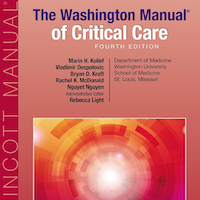Tag: sepsis
Fluid boluses and infusions in the early phase of resuscitation from septic shock and sepsis-induced hypotension
Fluid administration is the first line treatment in intensive care unit (ICU) patients with sepsis and septic shock. While fluid boluses administration can be titrated by predicting preload dependency, the amount of other... read more
Longitudinal Vasoactive Inotrope Score Trajectories and Their Prognostic Significance in Critically Ill Sepsis Patients
This study offers significant insights into the prognostic value of VIS trajectories in sepsis patients. The identification of distinct trajectory patterns not only underscores the heterogeneity in sepsis but also emphasizes... read more
Endothelial Activation and Microcirculatory Disorders in Sepsis and Critical Illness
The endothelium is one of the largest organs in the human body and lines the blood vessels and microcirculation of all the vital organs. As such, it functions as a massive and critical surveillance system to orchestrate recognition... read more
Efficacy of β-Blockers in Decreasing Mortality in Sepsis and Septic Shock Patients
This study suggests that the use of β-blockers in sepsis and septic shock patients is associated with a significant decrease in in-hospital mortality and also associated with better patient outcomes. As β-blockers cause... read more
Risk Factors for Mortality in Patients with Sepsis or Sepsis-associated Delirium Based on the MIMIC-IV Database
Research on the severity and prognosis of sepsis with or without progressive delirium is relatively insufficient. We constructed a prediction model of the risk factors for 28-day mortality in patients who developed sepsis... read more
Effectiveness of Fludrocortisone and Hydrocortisone vs. Hydrocortisone Alone in Septic Shock
Steroid use in sepsis is controversial. For example, fludrocortisone–hydrocortisone together may improve survival in septic shock, while hydrocortisone alone may not. A recent subgroup analysis of the APROCCHSS trial... read more
BPRI and Clinical Outcomes in Patients with Septic Shock
Use of the novel dose-effect index, Blood Pressure Response Index (BPRI) was proposed to allow rapid bedside assessment of the reactivity of septic shock patients to vasoactive drugs, as isolated MAP or VIS cannot reflect... read more
Fluid Accumulation Syndrome in Sepsis and Septic Shock
In this review, we aimed to comprehensively summarize current literature on pathophysiology, relevance, diagnosis and treatment of fluid accumulation in patients with sepsis/septic shock. Fluid accumulation syndrome (FAS)... read more
The Easiest Way to Reduce Antibiotic Resistance Might be Shorter Duration
Antibiotic stewardship garners a lot of attention these days, but we face unique challenges to execute guidelines successfully given that we write more than 13 million antibiotic prescriptions every year in EDs. Variations... read more
The Washington Manual of Critical Care 4th Edition
Part of the popular Washington Manual® handbook series, The Washington Manual of Critical Care provides concise, high-yield content that reflects today’s fast-changing advances in the field. Edited by Drs. Marin H. Kollef,... read more

Trends in Empiric Broad-Spectrum Antibiotic Use for Suspected Community-Onset Sepsis in US Hospitals
Empiric treatment for suspected community-onset sepsis accounts for about half of broad-spectrum antibiotic use in US hospitals even though resistant organisms are isolated in only 7% of patients with community-onset sepsis... read more
Complex Infusion Volumes Interaction and Confounding Factors with Lactate Clearance in Septic Shock
A recent article by Ahlstedt et al. published in Intensive Care Medicine examining the impact of restrictive fluid management on lactate clearance in septic shock patients within the intensive care unit (ICU) piqued our interest.... read more
Sepsis Alert Systems, Mortality, and Adherence in Emergency Departments
This systematic review and meta-analysis demonstrated the significant association of implementing sepsis alert systems in the Emergency Departments (ED) with patient outcomes. These findings indicate that sepsis alert... read more
Predictive Value of Multiple Scoring Systems in the Prognosis of Septic Patients with Different Infection Sites
The heterogeneity nature of sepsis is significantly impacted by the site of infection. This study aims to explore the predictive value of multiple scoring systems in assessing the prognosis of septic patients across different... read more
Early vs. Delayed Enteral Nutrition in ICU Sepsis Patients
Early enteral nutrition may not affect mortality rates when analyzed using propensity score matching. However, our findings indicate that early enteral nutrition is associated with shorter ICU stays and a lower incidence... read more
Hydrocortisone, Ascorbic Acid, and Thiamine Combination Therapy Efficacy for the Management of Sepsis and Septic Shock
In this systematic review, we found that hydrocortisone, ascorbic acid, and thiamine (HAT) regimen may be useful for reducing the duration of vasopressor use and improve organ functions in patients with sepsis and septic... read more
Sepsis-induced coagulopathy: a matter of timeline
Leone et al. have nicely outlined the most frequent questions about thrombocytopenia in sepsis. Besides thrombocytopenia, sepsis indeed induces numerous pathophysiological changes. Among these, the acute-phase response... read more
Hepatorenal Syndrome in the ICU
Patients with cirrhosis are susceptible to develop acute kidney injury (AKI), a complication that occurs in up to 50% of hospitalized patients [80% in the intensive care unit (ICU)], and has been associated with increased... read more
Diagnosing Sepsis: Where We’re At And Where We’re Going
Diagnosing sepsis remains problematic. Pathogen identification is frequently lacking and the dysregulated host response is non-specific. Blood cultures often take days to deliver a result and, even then, approximately 90%... read more
Sepsis Mortality Among ICU Patients with Hematological Malignancy
Over the past two decades, there have been substantial improvements in mortality in hematological malignancy patients with sepsis, including across all levels of illness severity and in patients requiring mechanical ventilation.... read more
Vasopressor Reduction Effect of Polymyxin B Hemoperfusion
This study aimed to evaluate the effect of polymyxin B hemoperfusion (PMX-HP) in patients with peritonitis-induced septic shock who still required high dose vasopressors after surgical source control. A total of 338 patients... read more
Remimazolam Effect on Hemodynamics in Patients with Septic Shock
Remimazolam is safe and effective for inducing general anesthesia in patients with septic shock. Low, medium, and high doses of remimazolam can maintain a stable hemodynamic state, and the recovery of hepatic and renal function... read more









